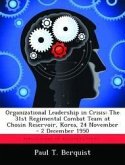Many look with amazement at the rebirth of the nation of Japan from the ashes of World War II. This is a study of the postwar military government and administration of Japan. It will examine the detailed preparation, the initial objectives, and the execution of the occupation by the United States (US)-led forces. The military government and civil affairs doctrine used, will be analyzed. The lessons gained from this study should be useful to the expeditionary army today. The military government teams that executed the policies of the occupation at the prefecture level will be a focus of this study. This study will provide insights into what made the occupation of Japan, 1945-1950, so successful. The lasting peace and prosperity of modern-day Japan makes this endeavor, by the US and her Allies, worthy of renewed study and possible application today. This work has been selected by scholars as being culturally important, and is part of the knowledge base of civilization as we know it. This work was reproduced from the original artifact, and remains as true to the original work as possible. Therefore, you will see the original copyright references, library stamps (as most of these works have been housed in our most important libraries around the world), and other notations in the work. This work is in the public domain in the United States of America, and possibly other nations. Within the United States, you may freely copy and distribute this work, as no entity (individual or corporate) has a copyright on the body of the work. As a reproduction of a historical artifact, this work may contain missing or blurred pages, poor pictures, errant marks, etc. Scholars believe, and we concur, that this work is important enough to be preserved, reproduced, and made generally available to the public. We appreciate your support of the preservation process, and thank you for being an important part of keeping this knowledge alive and relevant.
Bitte wählen Sie Ihr Anliegen aus.
Rechnungen
Retourenschein anfordern
Bestellstatus
Storno









